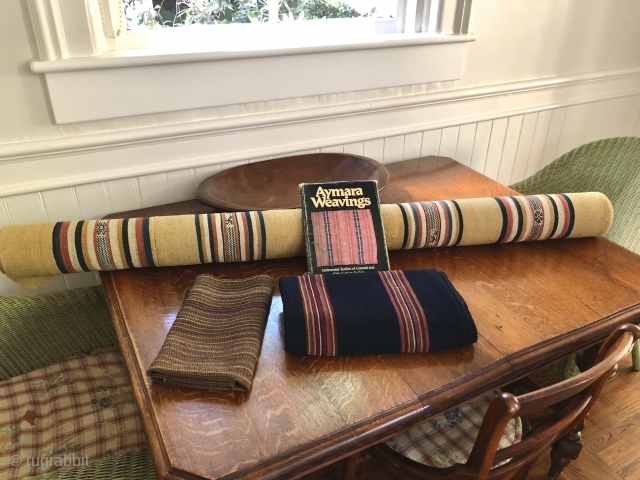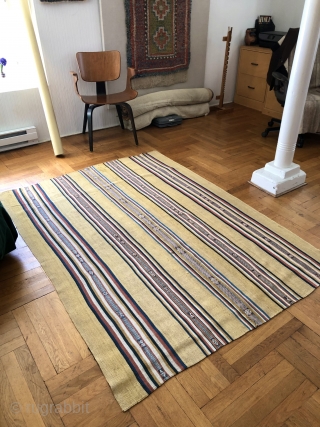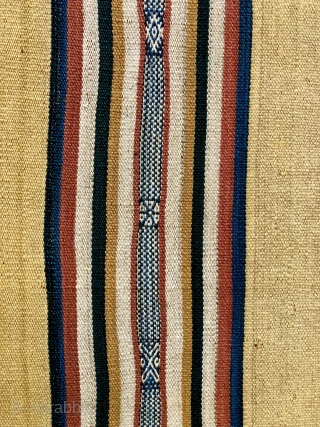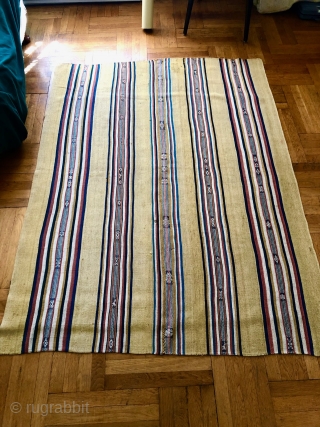Back
One of only three examples of a 19th century Aymara ceremonial weaving made in a blanket format known. When the first two of these unusual pieces appeared on the market in the early 1980's they were thought to be ponchos because of their poncho-like dimensions and because they were opened up along the center seam to create a poncho-like neck slit. The unusual blanket-like handle and high loft of the alpaca yarns in these pieces was considered quite unique and therefore very desirable. This piece was the third and last example to come along during that period or since. Because this yellow ground example had its original center seam still intact and because of its soft blanket-like handle it was determined that it was most likely not made as a poncho, but rather as a blanket. If this piece hadn’t come along when it did with its original seam, the other two weavings of the group would have been designated as very unusual and rare poncho types. All three of these blankets came from the same remote area of the Bolivian altiplano as indicated by fiber type, spin, color and design. The blanket format could have been unique to this area or family since no others have come to market in all these years. They were undoubtedly made for a special occasion – perhaps a wedding ceremony - this can be surmised because other blanket types are always made with yarns that are undyed, natural colored Llama fiber with no patterning in the bands - not naturally dyed soft alpaca fiber as in this type. This example was the only one of the three pieces with a yellow ground color – something rarely seen in other Aymara textiles from the 19th century or before. All dyes are natural. Judging from its color palette it could have come from the Southern region of the Bolivian Altiplano, but its exact origin remains a mystery. The weaving contains a number of subtle bi-chrome yarns known as chimi. The scale of the bands is impressive. Size: 60 x81 inches. One of the other pieces of this type was collected by Cathryn Cootner. Unfortunately i do not have images of the other two examples, but they all appeared to be about the same age - possibly early 19th century.
price:
SOLD
- Home
- Antique Rugs by Region
- Category
- Profiles
- Post Items Free
- Albums
- Benaki Museum of Islamic Art
- Budapest: Ottoman Carpets
- Gulbenkian Museum
- Islamic Carpets. Brooklyn
- Islamic Textiles. Brooklyn
- Konya Museum: Rugs
- MKG, Hamburg
- MMA: Caucasian Carpets
- MMA: Mamluk Carpets
- MMA: Mughal Indian Carpets
- MMA: Ottoman Carpets
- MMA: Safavid Persian Carpets
- MMA: Turkmen Rugs
- McCoy Jones Kilims
- Ottoman textiles. Met
- Philadelphia Museum
- Rugs and Carpets: Berlin
- Seljuqs at the Met
- TIEM, Istanbul: Carpets
- V&A: Classical Carpets
- Vakiflar Carpets: Istanbul
- Baluch Rugs: Indianapolis
- Gallery Exhibitions
- Jaf an Exhibition
- Alberto Levi Gallery
- Andean Textile
- Christie's London: 2016
- Francesca Galloway
- HALI at 40
- ICOC Washington, DC 2018
- Jajims of the Shahsavan
- London Islamic Week April, 2018
- Mongolian Felts
- Navajo Rugs: JB Moore
- Persian Piled Weavings
- SF Tribal & Textile Art Show 2020
- SF Tribal 2019
- Sotheby's: C. Alexander
- Turkish Prayer Rugs
- Turkmen Main Carpets ICOC 2007












